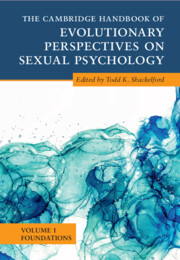Book contents
- The Cambridge Handbook of Evolutionary Perspectives on Sexual Psychology
- The Cambridge Handbook of Evolutionary Perspectives on Sexual Psychology
- Copyright page
- Contents
- Contributors
- Preface
- Part I Foundations of Evolution
- Part II Middle-Level Theories
- 7 Parental Investment Theory
- 8 Parent–Offspring Conflict
- 9 Theory and Evidence for Reciprocal Altruism
- 10 Life History Theory and Mating Strategies
- 11 Sperm Competition Theory
- 12 Sexual Conflict Theory
- 13 Cross-Species Comparisons
- 14 Cross-Cultural Methods in Sexual Psychology
- 15 Behavioral Genetics
- 16 Sex Differences and Sex Similarities
- 17 Individual Differences in Sexual Psychology
- 18 Experimental Methods in Sexual Psychology
- Index
- References
18 - Experimental Methods in Sexual Psychology
from Part II - Middle-Level Theories
Published online by Cambridge University Press: 30 June 2022
- The Cambridge Handbook of Evolutionary Perspectives on Sexual Psychology
- The Cambridge Handbook of Evolutionary Perspectives on Sexual Psychology
- Copyright page
- Contents
- Contributors
- Preface
- Part I Foundations of Evolution
- Part II Middle-Level Theories
- 7 Parental Investment Theory
- 8 Parent–Offspring Conflict
- 9 Theory and Evidence for Reciprocal Altruism
- 10 Life History Theory and Mating Strategies
- 11 Sperm Competition Theory
- 12 Sexual Conflict Theory
- 13 Cross-Species Comparisons
- 14 Cross-Cultural Methods in Sexual Psychology
- 15 Behavioral Genetics
- 16 Sex Differences and Sex Similarities
- 17 Individual Differences in Sexual Psychology
- 18 Experimental Methods in Sexual Psychology
- Index
- References
Summary
Psychological research is often organized into three broad categories: true experiments, quasi-experiments, and nonexperiments. Evolutionary psychology is no exception to this. In this chapter, we define and describe these categories, and discuss various evolutionary psychological studies (and their results) within these categories. The benefits and limitations of these designs are also discussed. Evolutionary psychologists have employed a wide array of true experiments, quasi-experiments, and nonexperiments to examine sexual behaviors. These methods range from simple self-reports (both quantitative and qualitative) and validated scales to naturalistic observations, complex manipulations of participants’ environments, longitudinal studies, meta-analyses, and creative dependent measures of perception, preferences, and behavior. Journals that may serve as publication outlets for evolutionary perspectives on sexual psychology are also mentioned.
- Type
- Chapter
- Information
- Publisher: Cambridge University PressPrint publication year: 2022



